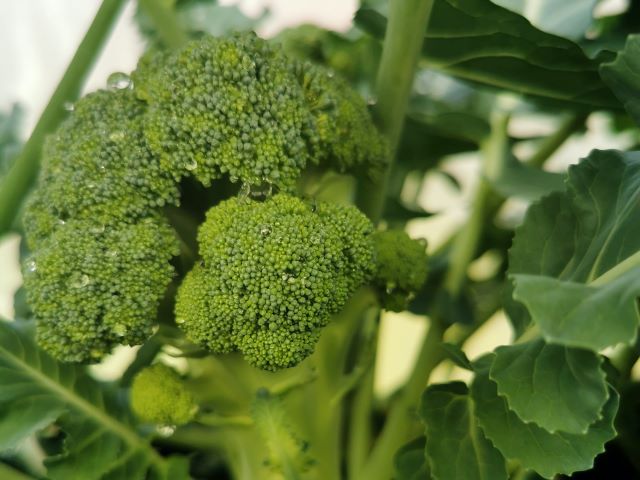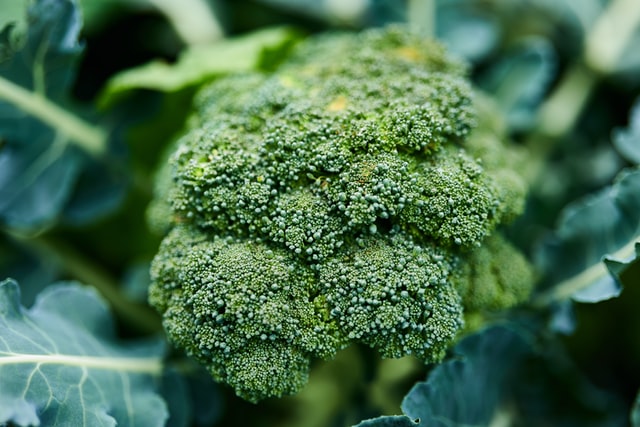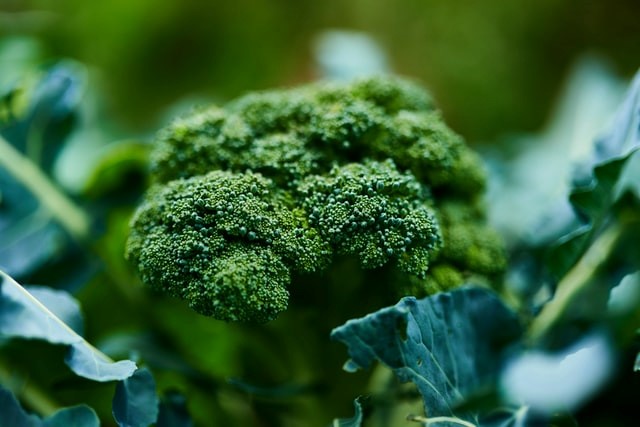Growing broccoli is a wonderful way to have a great supply of this delicious vegetable. And it always tastes better when you grow it yourself. But what do you do if your broccoli is turning yellow?
Broccoli turning yellow is typically a sign of poor health. Healthy broccoli is a lovely green color. If your broccoli is turning yellow, it’s likely due to an issue that you can treat or prevent.

So what’s the answer to broccoli turning yellow? In this post, I’ll explore the causes of broccoli turning yellow, and what you can do about them.
Broccoli plants can turn yellow because of natural aging, nutrient deficiencies, watering problems, or lack of sunlight. As with many plants, pests and diseases can also be a factor.
So let’s find out more.
Related: How To Grow Broccoli: Planting, Caring and Harvesting Broccoli
Table of Contents
Broccoli Plants Turn Yellow Because of Age

The most common reason that broccoli plants turn yellow is actually a simple one: they’re aging.
When broccoli is mature, it will be a deep green color all around, in the florets and the leaves. There are also those bumps in the heads of broccoli — those are flower buds getting ready to bloom.
If the broccoli plant is allowed to keep growing, these buds will flower. This saps energy from the rest of the plant, as it focuses entirely on flowering. Then the rest of your broccoli will start to turn yellow.
Broccoli that has started yellowing because of age is still edible, although not nearly as tasty. It is more bitter and doesn’t have as many nutrients in it.
To prevent broccoli from yellowing due to age, you have to harvest it at the right time. When the head stops growing, and the whole broccoli plant is a rich green color, and the buds are tight but haven’t opened yet, it should be ready for harvesting.
Harvesting broccoli at the right time is the best way to prevent it from aging further and yellowing. Once it has started yellowing, you can still eat it, but it won’t be as good.
Nitrogen Deficiency Causes Broccoli to Yellow
Broccoli plants need a lot of nitrogen. It helps them grow, produce more, and helps them flower. It’s an essential nutrient that they can’t live without.
If broccoli plants aren’t getting enough nitrogen, the first thing that’s likely to happen is they will start to yellow. The yellowing will start with the leaves, and then the other parts of the broccoli plant. Sometimes the yellowing starts at the edge of the leaves.
If you notice this, don’t rush to add more nitrogen. First, you should use a soil test kit to make sure that you really do have a nitrogen deficiency, to be sure you’re treating for the right issue.
Adding more nitrogen when you already have enough can be harmful. If the test shows that you need more, though, it’s easy to add. Adding organic compost, an organic fertilizer or some blood meal is a great way to add nitrogen to the soil.
Once you do this, your broccoli will start getting better quickly. Nitrogen deficiencies are easy to treat once you spot them.
Related: Why Is My Broccoli Flowering? Causes and Solutions!
Watering Problems in Broccoli Cause Yellowing
Broccoli, of course, also needs water. And it needs the right amount of water. Giving too much or too little can cause the broccoli plant to start yellowing.
Too little water will result in broccoli leaves wilting and starting to yellow. Eventually, they will drop off, and the rest of the plant will follow suit.
If you notice your broccoli leaves starting to wilt, feel the soil. If the top couple inches are dry, it’s time for watering. Your broccoli will bounce back very quickly once you water it.
On the other hand, you can also overwater broccoli. Broccoli needs about 1 to 1.5 inches of water every week. Giving it too much can cause growth problems.
Overwatering broccoli can lead to waterlogged roots, which then have trouble absorbing essential nutrients. If your soil is waterlogged, simply let it dry out a bit before watering again.
Sometimes, overwatering leads to root rot, a fungal disease. It will cause the roots of your broccoli to turn dark and mushy. Once this takes hold, there isn’t much you can do. You can try digging up the plant, removing the infected roots, and letting it dry out. If that doesn’t work, you should remove it so it doesn’t spread to other plants.
So, whether you do too much or too little, the wrong amount of water can harm broccoli plants. Check the top couple inches of soil, and if they’re dry, then you should water them.
Not Enough Sunlight Causes Yellowing Broccoli

Broccoli plants like to get a fair amount of sun — about 6 hours of direct light every day. If they don’t get this much, broccoli leaves will start to yellow.
Not getting enough sunlight means the broccoli plant can’t engage in photosynthesis as much as it needs to. This causes the leaves to yellow, which is a sign of an ailing broccoli plant.
To fix this issue, simply move your broccoli somewhere with more sunlight. If it’s getting overshadowed by other plants, try to move them out of the way.
Remember, though, that while broccoli likes sunlight, it doesn’t like a lot of heat. If too much direct sunlight is drying out the soil quickly, you can move it somewhere where it gets more indirect light, but still gets a lot of it.
Diseases That Cause Broccoli Plants to Yellow
There are a lot of diseases that broccoli can get, but there are a few common ones that cause the plant to yellow. These are the ones to look out for.
Clubroot is a fungal infection. It causes the roots of broccoli plants to swell and grow galls or tumors. This prevents the plant from absorbing nutrients the way it needs to, and the broccoli will yellow and wilt.
The only way to identify clubroot is to check your plant’s roots. Be careful when doing this, to minimize stress on the broccoli. Once clubroot takes hold, there isn’t much to do to treat it, aside from removing infected plants to prevent its spread. However, you can prevent it from starting by keeping the soil pH between 6-7, as clubroot thrives in acidic soil.
Fusarium wilt is another fungal disease. This one tends to work its way up from the bottom of the broccoli plant, so you may notice yellowing at the bottom first. It will also stunt the growth of the broccoli plant, and eventually, the plant will die.
Like many fungal diseases, fusarium wilt is hard to treat. You can try an organic biofungicide like this one. You can also prevent it by not overwatering your broccoli. If you can’t get rid of it, it’s best to remove infected plants to prevent it from spreading.
Lastly, anthracnose is yet another fungal disease. It starts by yellowing the tips of the broccoli leaves, and then spreads to the rest of the plant. Again, you can prevent it by avoiding excessive moisture.
You can also try the biofungicide for anthracnose. If it doesn’t work, remove infected plants so it doesn’t spread to the rest of your broccoli.
Broccoli Turning Yellow Because of Pests
There are a lot of broccoli pests, but two common ones can cause the plant to turn yellow.
The first are cabbage worms. These are the larvae of a type of moth. If you notice white and gray moths around your broccoli plants, it’s likely you’ll soon be dealing with cabbage worms.
These worms feed on the leaves of your broccoli, causing them to yellow. Spraying the plant with a mixture of horticultural neem oil and water will help kill off these pests. You can also try adding helpful bugs like ladybugs to feed on or scare off garden pests.
The other main broccoli pest that can cause yellowing is aphids. These tiny insects feed on the broccoli plant, causing discolored leaves. They also leave behind a sweet, sticky substance known as honeydew, which can attract other bad insects.
To get rid of aphids, you can wash your broccoli with a spray of strong water. If that doesn’t work, you can also use a spray with insecticidal soap or neem oil. Adding ladybugs can also help with aphids.
As you can see, broccoli pests are easy to fight off with simple, organic methods. Diseases can be harder to treat, and the best treatment for them is prevention.
Related: What’s Eating My Broccoli? (And how to get rid of them!)
Further reading:
- Eating Broccoli Leaves and Flowers With Recipe Ideas
- Why Is My Broccoli Dying? Causes and Solutions
- Beet Leaves Turning Yellow? Causes and Solutions
- Why Are My Leeks So Thin? (And how to fix them!)
- Why Are My Kale Seedlings Turning Yellow? Causes and Solutions
- 7 Reasons Globe Artichokes Are Small (With Solutions)
- 6 Causes Of Dying Kale (And How To Fix It!)
